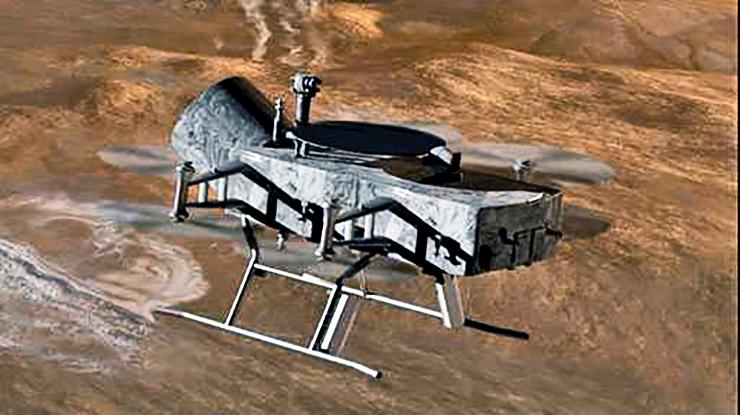On Thursday, NASA announced that its next space mission was to send a quadcopter named Dragonfly to Saturn’s largest moon, called Titan, looking for signs of life. Dragonfly will launch in 2026 and land on Titan in 2034.
BIG NEWS: The next @NASASolarSystem mission is… #Dragonfly – a rotorcraft lander mission to Saturn’s largest moon Titan. This ocean world is the only moon in our solar system with a dense atmosphere & we’re so excited to see what Dragonfly discovers: https://t.co/whePqbuGBq pic.twitter.com/BQdMhSZfgP
— Jim Bridenstine (@JimBridenstine) June 27, 2019
The quadcopter will be looking for prebiotic chemical processes common on both Titan and Earth. Dragonfly will be the first time NASA operates a multi-rotor vehicle for space exploration on another planet; it is classified as rotorcraft, has eight rotors and flies like a drone. Flying will be difficult and will use a lot of energy. This is because of Titan’s atmosphere is four times thicker than Earth’s.
NASA says the moon is comparable to Earth in its youth, can provide evidence to how life has evolved over millions of years.
Dragonfly will operate on Titian for three years, will explore diverse environments across the moon. It has several sensors that will study how far prebiotic chemistry may have progressed.
“With the Dragonfly mission, NASA will once again do what no one else can do,” said NASA Administrator Jim Bridenstine.
“Visiting this mysterious ocean world could revolutionize what we know about life in the universe. This cutting-edge mission would have been unthinkable even just a few years ago, but we’re now ready for Dragonfly’s amazing flight.”
Researchers used data from the Cassini-Huygens spacecraft that started its mission in 2004 and used sensors to scan through the moon’s haze. Cassini was able to detect clouds of methane and various geologic surfaces with only a few crater impacts.
NASA has said Titan’s atmosphere is “the most chemically complex in the solar system.”
Sometime in 2034, Dragonfly will land at the equatorial “Shangri-La” dune fields, which are similar to dunes in Namibia in southern Africa. For the next three years, Dragonfly will leapfrog around the moon, 5 miles at a time. At the end of its mission, it will reach the Selk impact crater, where there could be evidence of water and possible life.
Titan has a nitrogen-based atmosphere similar to Earth. However, Titan has clouds and rain of methane. The moon’s weather and surface processes could have enough to create life.
“Unveiling Titan is like reading a mystery novel,” said Dr. Charles Elachi, director of NASA’s Jet Propulsion Laboratory and team leader for the radar instrument on Cassini. “Each time you flip the page you learn something new, but you don’t know the whole story until you’ve read the whole book. The story of Titan is unfolding right before our eyes, and what we are seeing is intriguing.”
While everyone is focused on Mars and the Moon – it seems by the mid-2030s – human beings will get a glimpse of what it’s like on one of Saturn’s 62 confirmed moons.
via ZeroHedge News https://ift.tt/2JiQsNh Tyler Durden


